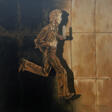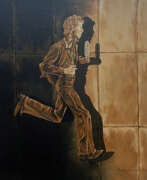Moscow Conceptualists

Moscow Conceptualists
The Moscow Conceptualists, a movement that began in the early 1970s and extended into the 1980s, represents a pivotal chapter in Russian art. This collective of artists, spearheaded by figures like Dmitri Prigov, Ilya Kabakov, Irina Nakhova, Viktor Pivovarov, Eric Bulatov, Andrei Monastyrski, and the duo Komar and Melamid, strived to challenge the socialist ideology prevalent in the Soviet Union. Their approach combined the tactics of conceptual and appropriation art, providing a stark contrast to the prevailing Socialist Realism.
One of the defining aspects of Russian Conceptualism, as articulated by Mikhail Epstein, is its departure from Western Conceptualism. In the West, conceptual art often replaces a real object with its verbal description. In contrast, Russian Conceptualism dealt with the absence of objects, creating an aura of emptiness and a connection to nothingness, which was deemed a fundamental characteristic of the movement.
Despite the innovative nature of their work, Moscow Conceptualists faced significant challenges in exhibiting their art due to the cultural and political atmosphere of the late Soviet Union. High-profile incidents like the Manezh exhibit of 1962 and the infamous Bulldozer Exhibition of 1974, where the authorities used bulldozers to disrupt and destroy the artworks, underscored these difficulties. These events also highlighted the limited exposure of Moscow Conceptualism outside the Soviet Union and its confinement within a narrow circle of Moscow artists and their acquaintances.
Their artworks varied greatly in form and expression. Ilya Kabakov's "The Great Axis" (1984) is a notable installation, portraying a symbolic connection between the earth and sky. Another notable work is "Room No. 3" by Irina Nakhova, which immerses the viewer in a dark, solitary environment. The artist duo Komar and Melamid also contributed significantly with their tongue-in-cheek projects, such as the fictional narrative of the serf artist Apelles Ziablov. Collective Actions, initiated by Andrey Monastyrsky, was another significant aspect of the movement, involving a group of artists performing enigmatic actions, often in outdoor settings.
The essence of Moscow Conceptualism, deeply rooted in the realities of Soviet life during the 1970s to 1980s, resonates with contemporary sensibilities, characterized by a distrust of official ideologies and a recognition of the constructed nature of linguistic and visual signs. This movement, particularly its second generation, marked a departure from traditional studio art, actively engaging the audience in the creation of the art and setting the foundation for a radical transformation in the landscape of Soviet and post-Soviet art.
For collectors and art enthusiasts, understanding the nuances and historical context of the Moscow Conceptualists is crucial. Their work represents a critical moment in art history, where artists actively challenged and reshaped the boundaries of artistic expression under restrictive political circumstances.
To stay informed about the latest sales and auction events related to Moscow Conceptualist art, we invite you to sign up for updates. This subscription will provide timely and focused information, ensuring you remain at the forefront of this remarkable art movement.
| Country: | Russia, USSR (1922-1991) |
|---|---|
| Start of the period: | 1970 |

